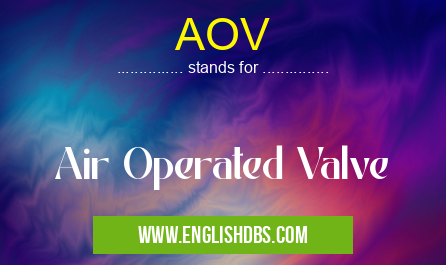What does AOV mean in UNCLASSIFIED
AOV (Air Operated Valve) is a valve that is actuated using pressurized air. These valves are widely used in various industrial applications due to their reliability, fast response time, and ability to handle high pressures and temperatures.

AOV meaning in Unclassified in Miscellaneous
AOV mostly used in an acronym Unclassified in Category Miscellaneous that means Air Operated Valve
Shorthand: AOV,
Full Form: Air Operated Valve
For more information of "Air Operated Valve", see the section below.
Construction and Operation
AOVs consist of a body, a piston, a diaphragm or bellows, and an air connection. The piston is connected to the valve seat, and when pressurized air is applied to the air connection, it forces the piston to move, opening or closing the valve. The diaphragm or bellows acts as a seal between the air connection and the valve body.
Types of AOVs
There are various types of AOVs based on their design and function:
- Shut-off valves: Used to completely stop the flow of fluid.
- Control valves: Used to regulate the flow rate of the fluid.
- Diverter valves: Used to switch the flow of fluid between two or more paths.
- Safety valves: Used to protect the system from overpressure or other hazardous conditions.
Advantages of AOVs
- Fast response time: Air actuation allows for quick opening and closing of valves.
- High pressure and temperature tolerance: AOVs can operate at high pressures and temperatures, making them suitable for demanding applications.
- Reliability: Air-operated valves are highly reliable and require minimal maintenance.
- Versatility: AOVs can be used with various fluids, making them suitable for a wide range of applications.
Essential Questions and Answers on Air Operated Valve in "MISCELLANEOUS»UNFILED"
What is an Air Operated Valve (AOV)?
An Air Operated Valve is a type of valve that is actuated using compressed air. It consists of a valve body, an actuator, and a solenoid valve. The actuator is connected to the compressed air supply and the solenoid valve is used to control the flow of compressed air to the actuator.
What are the advantages of using an AOV?
AOVs offer several advantages over other types of valves, including:
- Fast response times
- High flow rates
- Can be used in hazardous areas
- Can be remotely operated
What are the different types of AOVs?
There are various types of AOVs available, each designed for specific applications. Some common types include:
- Quarter-turn AOVs
- Globe AOVs
- Butterfly AOVs
- Diaphragm AOVs
- Pinch AOVs
How do I select the right AOV for my application?
The selection of the right AOV for a particular application depends on several factors, such as:
- The type of fluid being controlled
- The pressure and temperature of the fluid
- The required flow rate
- The installation environment
How do I maintain an AOV?
Proper maintenance is essential to ensure the optimal performance and longevity of an AOV. Regular maintenance tasks include:
- Inspecting the valve for leaks or damage
- Cleaning the valve and its components
- Lubricating the moving parts
- Testing the valve's functionality
Final Words: AOVs are essential components in various industrial processes, providing reliable and efficient control over fluid flow. Their ability to handle high pressures and temperatures, coupled with their fast response time and versatility, makes them a valuable asset in numerous applications.
AOV also stands for: |
|
| All stands for AOV |
